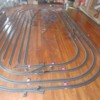I have not found a way to figure things out quickly and defintively using MTH material. I appreciate it if anyone can answer or point me to the correct forum.
Situation:
I'm building a medium large layout (all Realtrax) that will need power to run 5+ trains at a time, most with multiple units, so 5 to 12 powered units - only DCS. I've never used more than one transformer in past layouts and know one will run out of power on this layout. I have designed the layout to have two isolated sections (power districts?) I'm planning on powering my TIU with one Z4000.
Question:
1. Do I need to isolate the power districts?
2. If I do, do I need to remove all the jumpers on the isolated track pieces or do I need to keep one isolated (ground) jumper?
2a. If I need to keep one (assuming) it would it be the connecting the ground track for both power districts?
Great appreciation for you help! Jim







